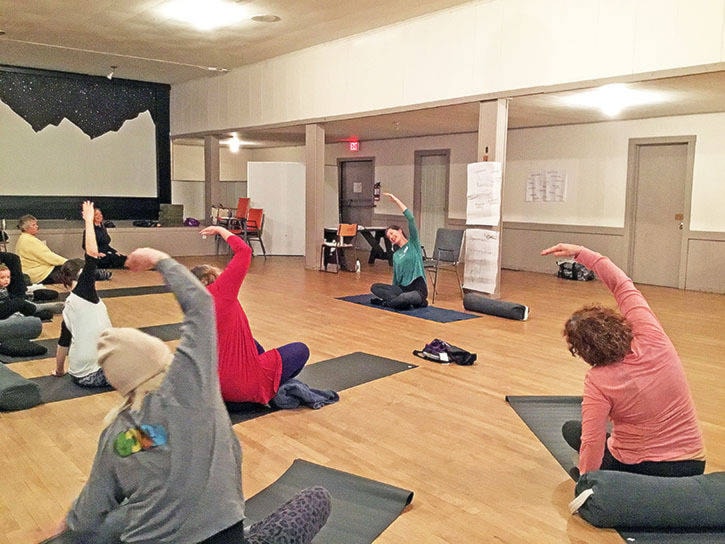It’s been five years since Fraser Health announced additional funding to improve the health outcomes of the region’s residents. From this funding, a steering committee was created with membership from Fraser Health, the District of Hope, FVRD Electoral Areas A and B, the Division of Family Practice, and First Nations Health Authority. Their goal succinct, yet complex: to find the best way to use the money.
Working with the District of Hope and other communities of the Fraser Canyon, including Boston Bar, Fraser Health has worked diligently at ensuring community-based actions are not only rooted in prevention and care management, but become the responsibility of the entire community.
A community-based system for health takes partnerships at the municipal level, the community-agency level, and the community level. After extensive consultation within the wider community, it was determined that enhanced transportation options, improvement to food security, access to specialists for those with chronic conditions, and the need for expanded volunteer opportunities were necessary to ensure Hope and area residents could all enjoy good health, and the benefits that come with being healthy. Youth and those living with mental health or substance use challenges were also prioritized.
Once finalized, these ideas became the Hope and Area Health and Wellbeing Plan, which expanded upon existing coordinator positions and focused on health services, youth, volunteers, mental health and substance use, and healthy living. Additionally, Transit’s volunteer driver program was expanded and matched funding provided by District of Hope to support the new BC Transit route #22.
Since launching in January 2017, the results have been impressive, said Petra Pardy, executive director of the Fraser Canyon Hospital, and the Hope and Area Healthy Communities Committee:Care Transit extended its services to Boston Bar, and were able to add many more cancer rides to Abbotsford or Vancouver. From the start until the end of the 2019-2020 fiscal year, the service provided 636 rides, covering 122,688 kilometres. Their volunteers logged 2645 hours in that time, or 110 days;
The Health Service Coordinator arranged for 19 specialists to come to Hope on a regular schedule, saving $397,466 in travel costs for Hope residents. Those specialists had 7,140 appointments in their first full three years;
The Volunteer Coordinator has 221 people in her volunteer pool where she matches volunteer interest with various organizations’ requests for volunteers;
The youth coordinator has supported 413 youth and the community connector has assisted 253 individuals with mental health and substance use challenges in connecting to programs and services;
The Healthy Living Coordinator worked with the District of Hope to create an enhanced smoking bylaw and worked with community partners in developing a food security strategy inclusive of the Agriculture Area Plan to protect and support agriculture and local food economy. She also worked with many partners in Hope to achieve second place in Canada in the inaugural ParticipACTION Community Better Challenge.
Also, from the funding allocated to regularize and coordinate services, funds were annually set aside to continually generate participation, innovation, and the promotion of health and well-being in local residents. From this saving plan comes two streams of money: a quarterly opportunity to apply for a micro health grant, and an annual opportunity to apply for a macro health grant. Each quarter, any individual, group or agency can apply for up to $10,000 for a one-time grant to support a new program, service or small equipment that promotes community health.
Since their inception, 42 micro health grants have supported fitness equipment purchases, physiotherapy, community gardens, trail developments, arts programs, new and upgraded playground equipment, and programs supporting inclusion, partnerships and well-being across the region.
The macro health grant offers $25,000 annually, and aims for a greater community impact. It fosters partnerships and is designed to leverage the grant to generate opportunities that can continue over time, encourage expansion of activities and seek possible future and larger funding opportunities.
For example, this funding has supported trail planning by successfully qualifying for a $500,000 rural dividend grant. This grant is what enabled the creation of the “Hope, Cascades, and Canyons” region for tourism marketing and asset development planning, which includes new trails, upgrades, and promotion of pedestrian connections.
The grant has also supported architectural drawings for a youth drop-in centre and a public transit bus loop for Yale First Nation.
”Many of these approved grants represents significant work and involvement of many committed individuals and agencies (throughout Hope and area),” said Pardy.
It’s only through “working together to support community members in Hope and communities of the Fraser Canyon (that we can help them) to achieve (their) best possible health outcomes. One can truly say it takes a community to promote wellness.”
For more information about micro or macro health grants, visit the Fraser Health website. The deadline for the next round of health grant applications is October 15th, 2021. For more information, email fhhopegrants@gmail.com, or call 604-217-3111.
@SarahGawdin
Sarah.Gawdin@hopestandard.com
Like us on Facebook and follow us on Twitter.
Want to support local journalism during the pandemic? Make a donation here.
